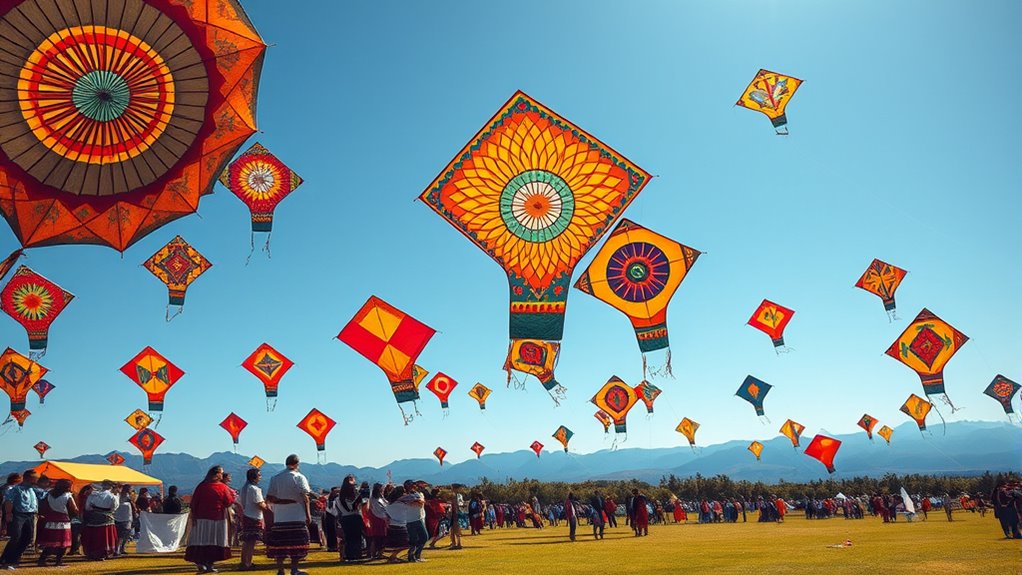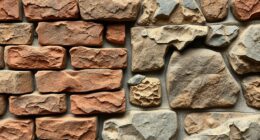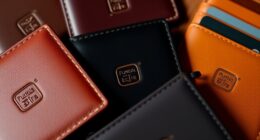During Guatemala’s Giant Kite Festival for All Saints Day, you’ll witness enormous, colorful kites that symbolize the spirits of loved ones passing to the heavens. These intricately crafted displays reflect centuries-old traditions blending indigenous beliefs and Catholic customs. The community works together to build and fly massive kites decorated with images of saints, legends, and symbols. If you explore further, you’ll discover how these kites honor ancestors and unite the community in a meaningful spiritual celebration.
Key Takeaways
- The festival is celebrated annually in Guatemala during All Saints Day, featuring large, colorful kites.
- Kites symbolize the souls of the departed ascending to the heavens, blending indigenous and Catholic traditions.
- Artisans craft intricate, large kites with vibrant fabrics, depicting legends, saints, or ancestral symbols.
- The event emphasizes community effort, cultural heritage, and spiritual connection through kite craftsmanship and flight.
- The festival offers a vibrant display of artistry and tradition, celebrating collective identity and honoring loved ones.

Every year in Guatemala, the Giant Kite Festival lights up the skies with vibrant colors and enormous kites that soar high above the city. As you watch these towering creations dance in the air, you’re witnessing not just a display of artistry but a rich tradition rooted in history and cultural expression. The festival’s origins trace back centuries, blending indigenous beliefs with Catholic traditions, specifically All Saints Day. It’s a time when communities come together to honor their loved ones who have passed, sending kites into the sky as offerings and messages of remembrance. This deep cultural significance is woven into every aspect of the festival, making it more than just a spectacle—it’s a spiritual and communal experience.
At the heart of the festival is impressive kite craftsmanship. These kites are not simple paper models; they are enormous, intricate works of art that require skill, patience, and ingenuity. You’ll notice the precision in their construction—sturdy frames, vibrant fabrics, and detailed decorations that often symbolize local legends, saints, or ancestral symbols. The process of creating these giant kites involves a community effort, with artisans and families dedicating days or even weeks to build them. The craftsmanship is passed down through generations, maintaining traditional techniques while sometimes incorporating modern materials for added durability. Watching artisans at work reveals a fascinating blend of tradition and innovation, a tribute to their dedication and mastery. Additionally, the traditional techniques used in kite construction are essential to preserving the cultural heritage of this unique festival.
The origins of the festival are deeply rooted in indigenous practices, where kite flying was believed to connect the living with the spiritual world. Over time, these customs merged with Catholic influences, leading to the modern celebration that now takes place during All Saints Day. You’ll see that each year, communities rally around this event, designing and building kites that reflect their heritage and hopes. The enormous kites, often measuring several meters across, are carefully constructed to withstand the wind and to be visually stunning from afar. As they take flight, they symbolize the souls of the departed ascending to the heavens, creating a powerful link between the living and the dead.
Participating in or simply observing the festival offers you a glimpse into a vibrant cultural tradition that’s alive and evolving. The artistry behind the kite craftsmanship, combined with its meaningful origins, makes the Giant Kite Festival an unforgettable experience—one where history, spirituality, and community spirit come together in the sky’s colorful tapestry.
Frequently Asked Questions
When Did the Giant Kite Festival Originate in Guatemala?
You might wonder about the history origins of the giant kite festival in Guatemala, which dates back centuries. It started as a way for locals to honor their ancestors and celebrate the Day of the Dead. The cultural significance is profound, symbolizing spiritual communication and community unity. Over time, this tradition grew into the vibrant festival you see today, blending indigenous customs with festive artistry that highlights Guatemala’s rich cultural heritage.
Are There Specific Materials Required to Make the Giant Kites?
When you consider the kite construction for giant kites, you’ll find that sourcing the right materials is essential. Typically, you need lightweight bamboo or sticks for the frame, strong twine or string for support, and colorful paper or fabric for the sail. You might also use glue and tape for assembly. Focusing on material sourcing helps guarantee your kite is sturdy enough for the festival’s impressive displays.
How Do Participants Prepare for the Festival Each Year?
You’ve got to stay ahead of the game when preparing for the festival. You gather materials for kite construction, like bamboo, paper, and glue, and plan your design carefully. You also coordinate festival logistics, such as arranging transportation and securing a spot for your kite display. Practice flying your kite to guarantee it’s sturdy. With good preparation, you’ll soar high and enjoy the vibrant celebration of All Saints Day.
What Is the Traditional Significance of the Kites’ Designs?
You should know that the traditional designs of the kites hold deep cultural symbolism and spiritual meanings. Each pattern often represents specific hopes, prayers, or messages to ancestors or spirits. Bright colors and intricate motifs are believed to attract positive energy and communicate respect. These designs aren’t just decorative; they embody the community’s beliefs, serving as a visual language that connects the living with the spiritual world during the festival.
Can Tourists Participate in Making or Flying the Kites?
You can definitely participate in making or flying the kites during the festival. Many local communities host kite making workshops where you can learn traditional techniques. Just make sure to follow the festival participation guidelines, which may include registration or respecting cultural customs. Engaging in these activities offers a unique experience, allowing you to connect with local traditions and contribute to the vibrant celebration of All Saints Day.
Conclusion
As you watch these towering kites dance against the sky, you feel the heartbeat of Guatemala’s vibrant soul. The Giant Kite Festival isn’t just a celebration—it’s a soaring symphony of colors and culture that lifts spirits high and connects hearts. So, next time you see a giant kite, remember you’re witnessing a living tapestry of tradition and hope, floating gracefully like dreams taking flight on All Saints Day.










